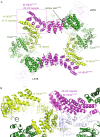4.4 Å Resolution Cryo-EM structure of human mTOR Complex 1
- PMID: 27909983
- PMCID: PMC5205667
- DOI: 10.1007/s13238-016-0346-6
4.4 Å Resolution Cryo-EM structure of human mTOR Complex 1
Abstract
Mechanistic target of rapamycin (mTOR) complex 1 (mTORC1) integrates signals from growth factors, cellular energy levels, stress and amino acids to control cell growth and proliferation through regulating translation, autophagy and metabolism. Here we determined the cryo-electron microscopy structure of human mTORC1 at 4.4 Å resolution. The mTORC1 comprises a dimer of heterotrimer (mTOR-Raptor-mLST8) mediated by the mTOR protein. The complex adopts a hollow rhomboid shape with 2-fold symmetry. Notably, mTORC1 shows intrinsic conformational dynamics. Within the complex, the conserved N-terminal caspase-like domain of Raptor faces toward the catalytic cavity of the kinase domain of mTOR. Raptor shows no caspase activity and therefore may bind to TOS motif for substrate recognition. Structural analysis indicates that FKBP12-Rapamycin may generate steric hindrance for substrate entry to the catalytic cavity of mTORC1. The structure provides a basis to understand the assembly of mTORC1 and a framework to characterize the regulatory mechanism of mTORC1 pathway.
Keywords: cryo-electron microscopy; mTORC1; structure.
Figures





Similar articles
-
Architecture of human mTOR complex 1.Science. 2016 Jan 1;351(6268):48-52. doi: 10.1126/science.aaa3870. Epub 2015 Dec 17. Science. 2016. PMID: 26678875
-
Cryo-EM structure of human mTOR complex 2.Cell Res. 2018 May;28(5):518-528. doi: 10.1038/s41422-018-0029-3. Epub 2018 Mar 22. Cell Res. 2018. PMID: 29567957 Free PMC article.
-
Structure of the human mTOR complex I and its implications for rapamycin inhibition.Mol Cell. 2010 Jun 11;38(5):768-74. doi: 10.1016/j.molcel.2010.05.017. Mol Cell. 2010. PMID: 20542007 Free PMC article.
-
Cryo-EM insight into the structure of MTOR complex 1 and its interactions with Rheb and substrates.F1000Res. 2019 Jan 3;8:F1000 Faculty Rev-14. doi: 10.12688/f1000research.16109.1. eCollection 2019. F1000Res. 2019. PMID: 30647914 Free PMC article. Review.
-
[New structures of mTORC1: Focus on Rag GTPases].Med Sci (Paris). 2021 Apr;37(4):372-378. doi: 10.1051/medsci/2021033. Epub 2021 Apr 28. Med Sci (Paris). 2021. PMID: 33908855 Review. French.
Cited by
-
Cryo-EM structure of human ATR-ATRIP complex.Cell Res. 2018 Feb;28(2):143-156. doi: 10.1038/cr.2017.158. Epub 2017 Dec 22. Cell Res. 2018. PMID: 29271416 Free PMC article.
-
Multifaceted role of mTOR (mammalian target of rapamycin) signaling pathway in human health and disease.Signal Transduct Target Ther. 2023 Oct 2;8(1):375. doi: 10.1038/s41392-023-01608-z. Signal Transduct Target Ther. 2023. PMID: 37779156 Free PMC article. Review.
-
Sensors for the mTORC1 pathway regulated by amino acids.J Zhejiang Univ Sci B. 2019 Sept.;20(9):699-712. doi: 10.1631/jzus.B1900181. J Zhejiang Univ Sci B. 2019. PMID: 31379141 Free PMC article. Review.
-
Clinically Precedented Protein Kinases: Rationale for Their Use in Neurodegenerative Disease.Front Aging Neurosci. 2020 Sep 2;12:242. doi: 10.3389/fnagi.2020.00242. eCollection 2020. Front Aging Neurosci. 2020. PMID: 33117143 Free PMC article. Review.
-
Mroh1, a lysosomal regulator localized by WASH-generated actin.J Cell Sci. 2017 May 15;130(10):1785-1795. doi: 10.1242/jcs.197210. Epub 2017 Apr 19. J Cell Sci. 2017. PMID: 28424231 Free PMC article.
References
-
- Chen SX, McMullan G, Faruqi AR, Murshudov GN, Short JM, Scheres SHW, Henderson R. High-resolution noise substitution to measure overfitting and validate resolution in 3D structure determination by single particle electron cryomicroscopy. Ultramicroscopy. 2013;135:24–35. doi: 10.1016/j.ultramic.2013.06.004. - DOI - PMC - PubMed
MeSH terms
Substances
LinkOut - more resources
Full Text Sources
Other Literature Sources
Molecular Biology Databases
Miscellaneous

